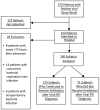The use of antimicrobial agents after diagnosis of viral respiratory tract infections in hospitalized adults: antibiotics or anxiolytics?
- PMID: 20923284
- PMCID: PMC3219040
- DOI: 10.1086/656596
The use of antimicrobial agents after diagnosis of viral respiratory tract infections in hospitalized adults: antibiotics or anxiolytics?
Abstract
Objective: Because extensive antibiotic use by inpatients has been associated with the development of multidrug-resistant organisms, we aimed to determine which variables were associated with the use of antibiotics after viral respiratory tract infection diagnosis among adult patients admitted to the hospital with respiratory symptoms.
Methods: A retrospective cohort study was conducted at 2 affiliated urban hospitals in Pennsylvania. We identified all adult patients admitted to the hospital during the period from November 1, 2005, through August 1, 2007, with a viral assay positive for influenza A or B, parainfluenza, adenovirus, or respiratory syncytial virus. Among these patients, we identified those who received antibiotics after the diagnosis of viral RTI. Data on demographics; comorbidities; and physical examination, laboratory, and radiographic findings were ascertained to identify risk factors for antimicrobial use among these patients.
Results: A total of 196 hospitalized patients with positive viral assay results were included; 125 of 131 patients administered antibiotics continued to receive them after viral RTI diagnosis. Among 52 patients with an abnormal chest radiograph, 46 continued antibiotic therapy. An abnormal chest radiograph was independently associated with continued antibiotic use (adjusted odds ratio, 4.28 [95% confidence interval, 1.71-10.77]; P = .002). However, the majority of patients (79 of 125 [63%]) who continued antibiotic therapy had normal chest imaging findings. Eight patients (6%) who continued antibiotic therapy and no patients who stopped developed C. difficile infection (95% CI, 1.5-∞; P = .05), but there was no significant difference in length of stay or mortality.
Conclusions: Antibiotics are commonly used to treat hospitalized patients with known acute viral RTIs. Continued use is strongly associated with abnormal radiograph findings at admission. However, the reasons for continuation of antibiotics in the treatment of the majority of patients with normal radiographs are unclear and may represent inappropriate use.
Figures


References
-
- Courcol RJ, Pinkas M, Martin GR. A seven year survey of antibiotic susceptibility and its relationship with usage. J Antimicrob Chemother. 1989;23(3):441–451. - PubMed
-
- Loeffler JM, Garbino J, Lew D, Harbarth S, Rohner P. Antibiotic consumption, bacterial resistance and their correlation in a Swiss university hospital and its adult intensive care units. Scand J Infect Dis. 2003;35:843–850. - PubMed
-
- Ayşe E, Aylin Ç Hürrem B, Mustafa AÇ, Matthew HS, önder E. Evaluation of antibiotic use in a hospital with an antibiotic restriction policy. Int J Antimicrob Agents. 2003;21(4):308–312. - PubMed
-
- Hecker MT, Aron DC, Patel NP, Lehmann MK, Donskey CJ. Unnecessary use of antimicrobials in hospitalized patients: current patterns of misuse with an emphasis on the antianaerobic spectrum of activity. Arch Intern Med. 2003;163(8):972–978. - PubMed
Publication types
MeSH terms
Substances
Grants and funding
LinkOut - more resources
Full Text Sources

